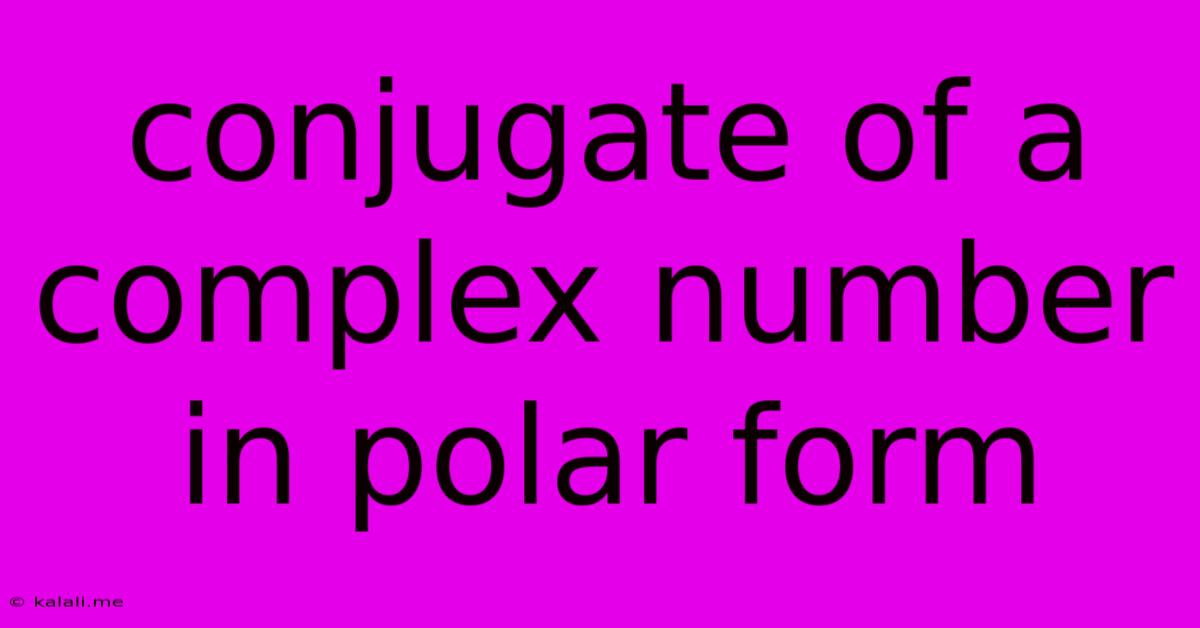Conjugate Of A Complex Number In Polar Form
Kalali
Jun 08, 2025 · 3 min read

Table of Contents
Conjugate of a Complex Number in Polar Form: A Comprehensive Guide
Understanding the conjugate of a complex number is fundamental in various areas of mathematics, particularly in complex analysis and signal processing. While the conjugate is easily found in rectangular form (a + bi), it's equally important to grasp its representation and properties in polar form, which often simplifies calculations. This article provides a comprehensive explanation of the conjugate of a complex number in polar form, along with illustrative examples.
What is a Complex Number?
Before diving into conjugates, let's briefly recap complex numbers. A complex number z is a number that can be expressed in the form a + bi, where a and b are real numbers, and i is the imaginary unit (√-1). a is called the real part (Re(z)) and b is the imaginary part (Im(z)).
Polar Form of a Complex Number
Complex numbers can also be represented in polar form using magnitude (or modulus) and argument (or angle). The polar form of a complex number z is given by:
z = r(cos θ + i sin θ)
where:
- r is the magnitude (or modulus) of z, calculated as r = √(a² + b²). This represents the distance from the origin to the point representing z in the complex plane.
- θ is the argument (or angle) of z, calculated as θ = arctan(b/a). This represents the angle between the positive real axis and the line connecting the origin to the point representing z in the complex plane. The range of θ is typically [-π, π].
The Conjugate of a Complex Number
The conjugate of a complex number z = a + bi, denoted as z̄ (or z<sup>*</sup>), is obtained by changing the sign of the imaginary part: z̄ = a - bi. Geometrically, the conjugate reflects the point representing z across the real axis in the complex plane.
Conjugate in Polar Form
To find the conjugate of a complex number in polar form, we consider the effect of conjugation on the magnitude and argument. The magnitude remains unchanged, while the argument is negated. Therefore, if z = r(cos θ + i sin θ), then its conjugate z̄ is:
z̄ = r(cos(-θ) + i sin(-θ))
Using trigonometric identities (cos(-θ) = cos θ and sin(-θ) = -sin θ), this simplifies to:
z̄ = r(cos θ - i sin θ)
Examples
Let's illustrate with examples:
Example 1:
Find the conjugate of z = 3 + 4i in polar form.
- Rectangular to Polar: First, convert z to polar form. r = √(3² + 4²) = 5, and θ = arctan(4/3).
- Conjugate in Polar Form: The conjugate in polar form is z̄ = 5(cos(-arctan(4/3)) + i sin(-arctan(4/3))). This simplifies to z̄ = 5(cos(arctan(4/3)) - i sin(arctan(4/3))).
- Polar to Rectangular (for verification): Converting back to rectangular form, we get z̄ = 3 - 4i, which is the correct conjugate.
Example 2:
Find the conjugate of z = 2(cos(π/6) + i sin(π/6))
The conjugate is simply z̄ = 2(cos(-π/6) + i sin(-π/6)) = 2(cos(π/6) - i sin(π/6)).
Properties of Conjugates
Conjugates possess several useful properties:
- z + z̄ = 2Re(z) (The sum of a complex number and its conjugate is twice its real part)
- z - z̄ = 2iIm(z) (The difference between a complex number and its conjugate is twice its imaginary part, multiplied by i)
- zz̄ = r² = a² + b² (The product of a complex number and its conjugate is the square of its magnitude, which is also the sum of the squares of its real and imaginary parts)
Understanding the conjugate of a complex number in polar form offers a powerful tool for simplifying calculations and gaining deeper insights into the nature of complex numbers. Its geometric interpretation and algebraic properties make it a crucial concept in various mathematical applications.
Latest Posts
Latest Posts
-
Why Does My Car Rev Up When I Start It
Jun 08, 2025
-
How Did Luke The Apostle Die
Jun 08, 2025
-
My Love For Life In Spanish
Jun 08, 2025
-
How Do You Know If You Need An Oil Change
Jun 08, 2025
-
Does The Catholic Church Believe In Evolution
Jun 08, 2025
Related Post
Thank you for visiting our website which covers about Conjugate Of A Complex Number In Polar Form . We hope the information provided has been useful to you. Feel free to contact us if you have any questions or need further assistance. See you next time and don't miss to bookmark.